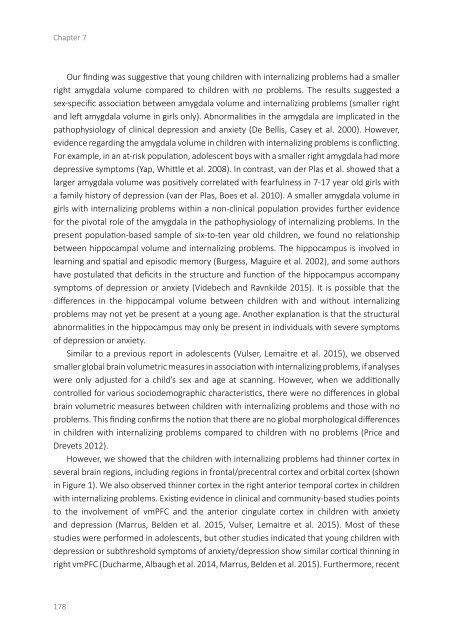On the Spectrum
2lm5UyR
2lm5UyR
Create successful ePaper yourself
Turn your PDF publications into a flip-book with our unique Google optimized e-Paper software.
Chapter 7<br />
Our finding was suggestive that young children with internalizing problems had a smaller<br />
right amygdala volume compared to children with no problems. The results suggested a<br />
sex-specific association between amygdala volume and internalizing problems (smaller right<br />
and left amygdala volume in girls only). Abnormalities in <strong>the</strong> amygdala are implicated in <strong>the</strong><br />
pathophysiology of clinical depression and anxiety (De Bellis, Casey et al. 2000). However,<br />
evidence regarding <strong>the</strong> amygdala volume in children with internalizing problems is conflicting.<br />
For example, in an at-risk population, adolescent boys with a smaller right amygdala had more<br />
depressive symptoms (Yap, Whittle et al. 2008). In contrast, van der Plas et al. showed that a<br />
larger amygdala volume was positively correlated with fearfulness in 7-17 year old girls with<br />
a family history of depression (van der Plas, Boes et al. 2010). A smaller amygdala volume in<br />
girls with internalizing problems within a non-clinical population provides fur<strong>the</strong>r evidence<br />
for <strong>the</strong> pivotal role of <strong>the</strong> amygdala in <strong>the</strong> pathophysiology of internalizing problems. In <strong>the</strong><br />
present population-based sample of six-to-ten year old children, we found no relationship<br />
between hippocampal volume and internalizing problems. The hippocampus is involved in<br />
learning and spatial and episodic memory (Burgess, Maguire et al. 2002), and some authors<br />
have postulated that deficits in <strong>the</strong> structure and function of <strong>the</strong> hippocampus accompany<br />
symptoms of depression or anxiety (Videbech and Ravnkilde 2015). It is possible that <strong>the</strong><br />
differences in <strong>the</strong> hippocampal volume between children with and without internalizing<br />
problems may not yet be present at a young age. Ano<strong>the</strong>r explanation is that <strong>the</strong> structural<br />
abnormalities in <strong>the</strong> hippocampus may only be present in individuals with severe symptoms<br />
of depression or anxiety.<br />
Similar to a previous report in adolescents (Vulser, Lemaitre et al. 2015), we observed<br />
smaller global brain volumetric measures in association with internalizing problems, if analyses<br />
were only adjusted for a child’s sex and age at scanning. However, when we additionally<br />
controlled for various sociodemographic characteristics, <strong>the</strong>re were no differences in global<br />
brain volumetric measures between children with internalizing problems and those with no<br />
problems. This finding confirms <strong>the</strong> notion that <strong>the</strong>re are no global morphological differences<br />
in children with internalizing problems compared to children with no problems (Price and<br />
Drevets 2012).<br />
However, we showed that <strong>the</strong> children with internalizing problems had thinner cortex in<br />
several brain regions, including regions in frontal/precentral cortex and orbital cortex (shown<br />
in Figure 1). We also observed thinner cortex in <strong>the</strong> right anterior temporal cortex in children<br />
with internalizing problems. Existing evidence in clinical and community-based studies points<br />
to <strong>the</strong> involvement of vmPFC and <strong>the</strong> anterior cingulate cortex in children with anxiety<br />
and depression (Marrus, Belden et al. 2015, Vulser, Lemaitre et al. 2015). Most of <strong>the</strong>se<br />
studies were performed in adolescents, but o<strong>the</strong>r studies indicated that young children with<br />
depression or subthreshold symptoms of anxiety/depression show similar cortical thinning in<br />
right vmPFC (Ducharme, Albaugh et al. 2014, Marrus, Belden et al. 2015). Fur<strong>the</strong>rmore, recent<br />
178


